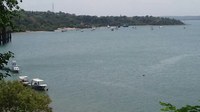A Passage from the Seychelles to Kenya
Here are some notes on a passage I made from Seychelles to Kilifi, Kenya, in August 2017 and some notes about Kilifi itself and Lamu. Kilifi and the East African coast is a hidden gem. The flavour of the month seems to be Madagascar, but now having sailed much of the coast between Lamu and Dar es Salaam, including Zanzibar, there is much to be said about this part of the world. Piracy seems to be a deterrent, but as you well know, with the exception of a couple of odd incidents off the northern Somalia coast, no ships have been taken in the region since 2012.
Published 7 years ago, updated 5 years ago
Passage from Seychelles to Kilifis
Timing:
The pilot books on the passage to and from Seychelles to East Africa indicate that 

East Africa current:
My impression from the pilot books on the subject was that the East Africa current started approximately fifty to one hundred miles offshore. Based on this I set a course for southern Pemba anticipating that the current would take me perpendicular to Kilifi. However, I did not pick up the current until I was within about twenty miles off the coastline having had to make a course correction to the north-west when closing in on Pemba.
KILIFI
Approaches to Kilifi:
The markers through the entrance between the reefs are difficult to spot. During daylight hours the seaward marker is squat and red and is reasonably easy to locate in the morning but almost impossible to see afternoon. It sits next to an angular white concrete and glass two-story house with a wall. However, the landward marker is hidden by bush and almost invisible. By following the line of vision from the beacon and along the wall will roughly give the line of approach. It is best to take a compass bearing on the visible beacon which is shown in The East Africa Pilot as a bearing of 272°. Best of all follow the track shown on your chart plotter. The second set of markers, once inside the reef, can be seen.
At night the lights on all the beacons are working though maintenance is sporadic. The reefs and passage through them are easy to locate at low tide.
Yachts making their way to Kilifi Boatyard are advised to follow closely the directions shown by Delwyn McPhun in the East Africa Pilot with regards to the approaches to the power line and bridge across Kilifi Creek.
N.B. Caution as the power line is very difficult to see.
Arrival in Kilifi:
I would recommend yachts coming to Kenya to make their landfall in Kilifi as the port is most geared up for them. Contact Kilifi Boatyard before arrival.
Harbor fees and other charges can vary from port to port. For instance, I heard of one yacht arriving in Mombasa being charged nearly $1 000.
Kilifi Boatyard can arrange for Immigration and Customs to come to their premises to deal with the formalities. Customs have an office in Kilifi and Immigration is in Malindi, an hour and a half away by road.
Kilifi Boatyard facilities:
o Moorings
o Security
o Cleaning and yacht care
o Water taxi service from yacht to shore and to Kilifi township
o Bar and restaurant facilities
o Showers
o Lift out with a full range of repair and maintenance facilities
o Dry out facilities alongside jetty
o Laundry
o Gas filling
o Sail and canvas repairs
o Assistance in importing parts and spares
o Limited chandlery
o Used chandlery and materials such as stainless steel and aluminum
o Storage facilities
o Contacts with marine suppliers worldwide and shippers to import chandlery
Fees:
Mooring fees are approximately $5 per foot per month.
Lift out for a 40’ yacht in and out including cradle is approximately $780.
Getting around of Kilifi:
Mombasa is about one hour by car away and Malindi one and a half hours. The choice of road transport is by motorbike (boda-boda), trishaw, taxi, Uber, mini-bus taxi (matatu) or bus.
There are regular and reasonably-priced flights to Nairobi from Malindi and Mombasa. In addition, there are no flights directly from Mombasa to international destinations via Ethiopia, Rwanda and the west-Asian hubs.
General:
Kilifi is a gem overlooked by the yachting fraternity. This is possible because of the Somali piracy problem. However, since 2012 the number of incidents has dropped to almost zero.
Apart from the magnificent creek with its beaches, mangroves and safe wind and kite surfing, it is close to the Tsavo with its complex of national and private game parks. There is also an active social life centered on the Boatyard and a selection of hotels and restaurants.
Kilifi town has a wide variety of basic shops, markets, and workshops. For the more discerning, Mombasa and Malindi are close by.
LAMU
Approach at night time:
Caution needs to be taken along the shipping channel against collision with unlit channel markers. In addition some have moved. Moreover be careful of moving from the shipping channel to the Shela anchorage as there are hidden rocks. It is better to approach close to the Peponi Hotel shore and between the markers at S2°17.5 and E40°55. If in doubt follow the local craft. Water taxis are available to take visitors in and around Lamu.
Anchoring:
It is not advisable to anchor off Peponi as there are strong tidal currents, particularly during springs, where the holding is indifferent. It is better to anchor off Shela.
Maurice Wainwright
The opinions expressed in this article are the author’s own and do not reflect the view of noonsite.com or the World Cruising Club.
Related to following destinations: Kenya, Kilifi, Seychelles
Related to the following Cruising Resources: Indian Ocean, Routing





